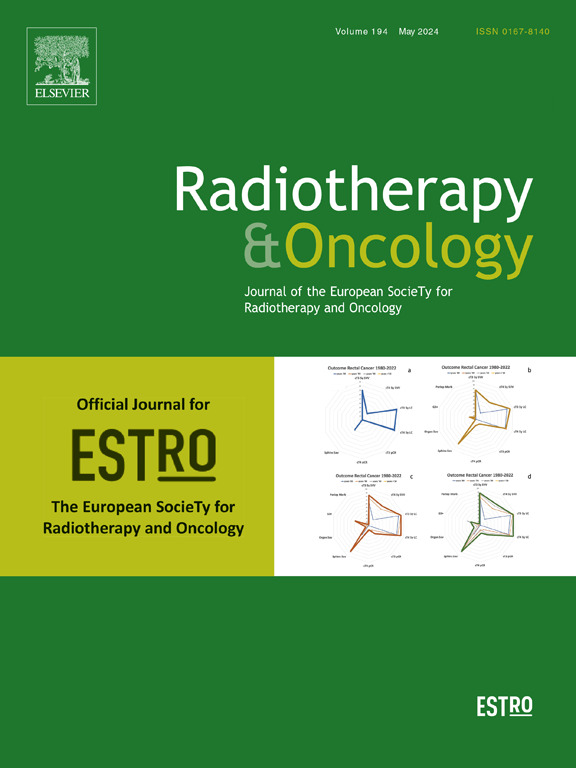An ultra-high dose rate Bragg peak tracking technique provides more affordable proton radiotherapy for cancer patients: From principle to experimental validation
IF 4.9
1区 医学
Q1 ONCOLOGY
引用次数: 0
Abstract
Purpose
This work aims to experimentally validate a novel cost-effective solution for achieving both conventional dose-rate and ultra-high dose rate (UHDR) deliveries in pencil beam scanning proton therapy.
Methods
A proton therapy delivery solution was previously developed by our group using only a single pristine Bragg peak of the highest energy proton beams from a cyclotron. This approach streamlines upstream beam modifiers, including energy degrader, selection and focusing systems, while utilizing of universal range shifters (URS) and range compensators (RCs) to preserve high beam transmission efficiency for UHDR beam delivery. It achieves the Bragg peak tracking and target dose conformity, making it potentially suitable for FLASH radiation therapy. In the current study, we highlighted the realization of the solution by using URS and customized beam-specific RCs via simulation in an in-house treatment planning software (TPS) which is then fabricated by a 3D printer, facilitating precise beam shaping and Bragg peak tracking. Experimental validation of this method was conducted using a clinical proton system to showcase a practical solution that can be translated into realistic operation. Both dose and dose rate were measured and compared to treatment planning results.
Results
The proton convolution superposition (PCS) dose calculation was benchmarked by the Monte Carlo calculation. Matrixx PT measured the delivered dose in the uniform and head-neck (HN) phantom, and the gamma passing rates were > 99 % in the water phantom. The gamma rate was > 98 % for the HN phantom for this distal tracking method. The measured dose difference between the TPS and HN phantom was < 2 %. The implementation of a high temporal resolution strip ion chamber detector array enabled accurate measurement of the spot time structure, facilitating 3D dose rate reconstruction across various beam currents.
Conclusion
The experimental validation successfully demonstrated the dosimetric accuracy and robustness of this proposed delivery method. The employment of the Bragg peak tracking method holds great promise for reducing treatment delivery costs for future UHDR and conventional dose rate proton radiation therapy, ultimately benefiting a larger population of patients.
超高剂量率布拉格峰跟踪技术为癌症患者提供更实惠的质子放疗:从原理到实验验证。
目的:本研究旨在通过实验验证一种新的具有成本效益的解决方案,以实现铅笔束扫描质子治疗中传统剂量率和超高剂量率(UHDR)的递送。方法:我们小组先前开发了一种质子治疗递送解决方案,仅使用来自回旋加速器的最高能量质子束的单个原始布拉格峰。该方法简化了上游波束调制器,包括能量衰减器、选择和聚焦系统,同时利用通用距离移位器(URS)和距离补偿器(rc)来保持超高dr波束传输的高传输效率。它实现了Bragg峰跟踪和目标剂量一致性,使其潜在地适用于FLASH放射治疗。在目前的研究中,我们强调了通过在内部治疗计划软件(TPS)中模拟使用URS和定制的光束特定rc来实现该解决方案,然后由3D打印机制造,从而促进精确的光束整形和布拉格峰跟踪。通过临床质子系统对该方法进行了实验验证,展示了一种可以转化为实际操作的实用解决方案。测量剂量和剂量率,并与治疗计划结果进行比较。结果:质子卷积叠加(PCS)剂量计算采用蒙特卡罗计算为基准。Matrixx PT测量了均匀和头颈(HN)模体的放射剂量,水模体的伽马通过率为 > 99 %。对于这种远端跟踪方法,HN假体的伽马率为 > 98 %。结论:实验验证了该方法的剂量学准确性和稳健性。Bragg峰跟踪方法的使用对于降低未来UHDR和传统剂量率质子放射治疗的治疗递送成本具有很大的希望,最终使更多的患者受益。
本文章由计算机程序翻译,如有差异,请以英文原文为准。
求助全文
约1分钟内获得全文
求助全文
来源期刊

Radiotherapy and Oncology
医学-核医学
CiteScore
10.30
自引率
10.50%
发文量
2445
审稿时长
45 days
期刊介绍:
Radiotherapy and Oncology publishes papers describing original research as well as review articles. It covers areas of interest relating to radiation oncology. This includes: clinical radiotherapy, combined modality treatment, translational studies, epidemiological outcomes, imaging, dosimetry, and radiation therapy planning, experimental work in radiobiology, chemobiology, hyperthermia and tumour biology, as well as data science in radiation oncology and physics aspects relevant to oncology.Papers on more general aspects of interest to the radiation oncologist including chemotherapy, surgery and immunology are also published.
 求助内容:
求助内容: 应助结果提醒方式:
应助结果提醒方式:


